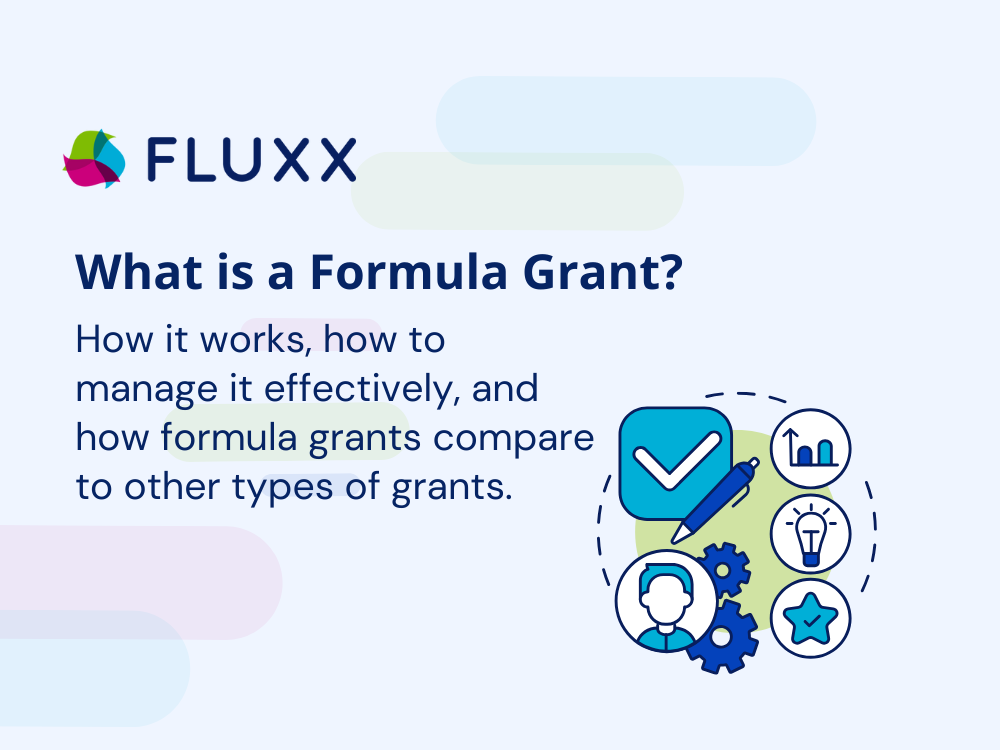What Are Formula Grants?
Discover what formula grants are, how they work, their key differences from other grant types, and how Fluxx's grant management system streamlines...
Be the first to know about new Fluxx grants management resources, blog articles and podcasts.


Not every grant awarded through government funding arises through competition. The most common of all federal funding, formula grants, is awarded on a non-competitive basis based on need, populations, or other pre-established criteria. These grants power much of the programming of the states and local government and provide the foundation of equal distribution of services to citizens.
Understand how formula grants work, and how best to administer them, is of relevance to all public administrators, grant officers, and policymakers. In today’s post, we’ll describe what a formula grant is, compare them with other types of funding, and describe best practices for administering them through all stages of the grant cycle.
A formula grant is a noncompetitive award by the federal government to the state or local government, territory, or eligible institution based on a formula established by law or regulation. Unlike discretionary grants, formula grants are not awarded competitively. In turn, awards are made based on pre-determined criteria such as:
The formula determines precisely how much each of the eligible recipients is set to be paid. Following the recipients' eligibility under the core requirements, funding is awarded automatically, yet reporting compliance requirements must still be met.
Formula grants can be utilized for funding population-wide large-scale programs dealing with education, public health, transportation, or housing. These programs can be multilevel fiscal year programs dealing with interagency and interdepartmental efforts at all governmental levels.
Formula grants allow for predictable, recurring public financing, yet like any other type of grant, tradeoffs exist.
For administrators, formula grants mean balancing predictable funding with complex compliance requirements and governmental accountability.
Grant formulas underpin much of the best government programs in the United States. The following are some of the most notable examples:
These programs all have formula approaches with allocations made equally, yet the recipients must deal with paperwork, performance monitoring, and achieving targets of compliance.
In order to comprehend formula grants more readily, it is helpful to contrast them with other kinds of federal funding:
|
Grant Type |
Allocation Method |
Examples |
Application Requirement? |
|
Formula Grants |
As per law-determining formula |
Medicaid, CDBG, Title I |
No |
|
Discretionary Grants |
Competitive review procedure |
NIH Research Grants, DOE Innovation Funds |
Yes |
|
Block Grants |
Broad formula-based with local flexibility |
TANF, Mental Health Block Grant |
Sometimes |
|
Earmark Grants |
Legislatively directed towards certain receivers |
Congressional appropriations bills |
No |
Formula grants occupy the space in between the rigid structure of discretionary spending and locally flexible block grants, presenting predictable funding with certain use scenarios.
A formula grant requires extensive coordination, appropriate data monitoring, and extensive regulatory expertise. Since formula grants are typically of large size and highly supervised, effective tools can eliminate non-compliance and waste.
Fluxx is specifically tailored to manage the complete lifecycle of such grants. With Fluxx, government agencies and administrators can:
Rather than administering formula grants using disconnected systems and spreadsheets, Fluxx-enabled agencies can keep abreast of reporting obligations, changes in funding, and compliance checks with ease.
Formula grants offer strong instruments of distributing resources based on need, with fairness, predictability, and scope. But managing them requires discipline, transparency, and expertise in aligning your internal systems with federal specifications.
Whether you're in charge of overseeing public health investments, education support, or building construction, having the correct tools at hand means that your team can focus on delivering results, not chasing spreadsheets.
Fluxx provides government grant administrators with everything they need to effectively manage formula grants—from compliance monitoring and reporting, through interagency collaboration and fund usage dashboards.
Ready to enhance your formula grant management? Schedule a demo today and see how Fluxx can keep your government agency responsible, coordinated, and focused on the mission.
Discover what formula grants are, how they work, their key differences from other grant types, and how Fluxx's grant management system streamlines...
Discover what Grants.gov is, how it works, the types of grants available, and how to use the platform effectively. Learn how Fluxx integrates with...
Discover what higher education grants management software is, how it differs from other systems, and how tools like Fluxx streamline grants...
Be the first to know about new Fluxx grants management resources, blog articles and podcasts.